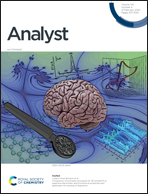3D paper-based microfluidic device: a novel dual-detection platform of bisphenol A†
Abstract
A novel platform of microfluidic paper-based analytical devices (μPADs) for dual detection of bisphenol A (BPA), a model analyte, was fabricated using an electronic digital plotter to create the stacked layer of μPADs and generate the lateral-flow channel without using an external pump. Two detection techniques, including electrochemical detection and laser desorption ionization mass spectrometric detection (LDI-MS), were used complementarily to improve the precision in the detection of BPA. The fluid sample was delivered to both detection zones by the capillary action, automatically generated from the fabricated microfluidic device. For an electrochemical sensor, two ballpoint pens filled with silver nanoparticles (AgNPs) and multiwall carbon nanotube (MWCNT) ink were used to print onto the paper with a contact printing method using a digital plotter. To further improve the sensitivity, zinc oxide (ZnO) was used to modify both electrochemical and LDI-MS detection zones. For BPA detection, high electrocatalytic properties and strong UV absorption of ZnO promote the electron transfer in the electrochemical sensor and ionization efficiency in LDI-MS with low interferences compared with a conventional organic matrix. Under optimal conditions, this platform showed a dual detection capability for BPA with a detection limit of 0.35 μM for electrochemical detection and with an ultralow detection limit of 0.01 pM for LDI-MS. This novel platform might be very useful for trace analyses requiring high precision detection of various analytes.



 Please wait while we load your content...
Please wait while we load your content...